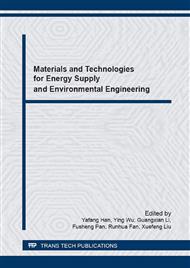[1]
W.X. Zhang, X. Li, N. Wei, M.X. Ma. Study on collagen extraction with enzyme, China Leather. 23(2006)15-17.
Google Scholar
[2]
K. Li, H. Chen, Y. Wang, Z. Shan, J. Yang, P. Brutto, A salt-free pickling regime for hides and skins using oxazolidine, J. Clean. Prod. 17 (2009) 1603-1606.
DOI: 10.1016/j.jclepro.2009.06.004
Google Scholar
[3]
V.J. Sundar, J. Raghava Rao, C. Muralidharan, Cleaner chrome tanning emerging options, J. Clean. Prod., 10 (2002) 69-74.
DOI: 10.1016/s0959-6526(01)00015-4
Google Scholar
[4]
J.M. Morera, E. Bartoli, R. Chico, C. Sole, L.F. Cabeza, Minimization of the environmental impact of chrome tanning: a new process reusing the tanning floats, J. Clean. Prod. 19 (2011) 2128-2132.
DOI: 10.1016/j.jclepro.2011.07.018
Google Scholar
[5]
L.M. Ortega, R. Lebrun, I.M. Noel, R. Hausler, Application of nanofiltration in the recovery of chromium(III) from tannery effluents, Sep. Purif. Technol. 44 (2005) 45-52.
DOI: 10.1016/j.seppur.2004.12.002
Google Scholar
[6]
P. Religa, A. Kowalil, P. Gierycz, Application of nanofiltration for chromium concentration in the tannery wastewater, J. Hazard. Mater. 186 (2011) 288-292.
DOI: 10.1016/j.jhazmat.2010.10.112
Google Scholar
[7]
J. Kanagaraj, N.K. Chandra Babu, A.B. Mandal, Recovery and reuse of chromium from chrome tanning waste water aiming towards zero discharge of pollution, J. Clean. Prod. 16(2008)1807- 1813.
DOI: 10.1016/j.jclepro.2007.12.005
Google Scholar
[8]
M. Fabbricino, B. Naviglio, G. Tortora, L.D. Antonio, An environmental friendly cycle for Cr(III) removal and recovery from tannery wastewater, J. Environ. Manage. 117 (2013) 1-6.
DOI: 10.1016/j.jenvman.2012.12.012
Google Scholar
[9]
Z.W. Ding, G.Y. Jia, Z.G. Ma, X.Y. Pang, System of reusing technologies for different leather wastes, China Leather. 38 (2009) 24-26.
Google Scholar
[10]
C.Y. Chen , H.J. Fan, P. Feng, Development of comprehensive utilization of leather solid waste, Leather Sci. Eng. 18 (2008) 27-33.
Google Scholar
[11]
Eleanor. M. Brown, The usage of leather waste, Leather Sci. Eng. 14 (2004) 7-11.
Google Scholar
[12]
P. Banerje, S. Madhu, N.K. Chandra Babu, C. Shanthi, Bio-mimetic mineralization potential of collagen hydrolysate obtained from chromium tanned leather waste, Mater. Sci. Eng. C. 49 (2015) 338-347.
DOI: 10.1016/j.msec.2015.01.027
Google Scholar
[13]
C.S. Cantera, M. deGiuste, A. Sofia, Hydrolysis of chrome shavings: application of collagen hydrolysate and acrylic-protein in post tanning operation, J. Soc. Leath. Tech. Ch. 81 (1997) 183-191.
Google Scholar
[14]
Z.W. Ding, S.X. Yu, W. Zhang, X.Y. Pang, Synthesis and applying of collagen protein retanning agent modified by amine resin, China Leather. 36 (2007) 54-57.
Google Scholar
[15]
W. Zhang, S.X. Yu, Z.W. Ding, C.J. Yang, J.Z. Jia, L.S. Yu, Preparation of KFC retanning-filling agent by modification of collagen peptide extracted from leather waste, China Leatehr. 35 (2006) 25-29.
Google Scholar
[16]
Z.G. Ma, W.J. Fan, Z.W. Ding, X.Y. Pang, Z.P. Cheng, Ultra-fine pulverizing of leather wastes and its application, China Leather. 39 (2010) 19-22.
Google Scholar
[17]
Z.P. Cheng, Z.W. Ding, X.Y. Pang, Y.F. Chen, Modification and Application of Leather superfine powder, China Leather. 42 (2013) 25-30.
Google Scholar
[18]
D.D. Zheng, K.Q. Shi, L. Jiang, L. Yu, G. Zhang, J. Lin, S.G. Shao, Enhancing the thermal stability of waste leather powder bu in-situ cooperative tannage, West Leather. 34 (2012) 19-22.
Google Scholar
[19]
A. Anumary, P. Thanikaivelan, M. Ashokkumar, R. Kumar, P.K. Sehgal, B. Chandrasekaran, Soft Mater. 11 (2011) 181-194.
DOI: 10.1080/1539445x.2012.617634
Google Scholar
[20]
Information on http: /www. cnki. net/kcms/detail/42. 1204.R. 20130516. 1151. 006. html.
Google Scholar


